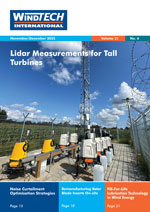 A new study by the Bundesverband Windenergie Offshore (BWO) reports that migratory birds almost completely avoid wind turbines, resulting in a far lower collision risk than previously assumed. The study, conducted by BioConsult SH, examined the actual collision risk in a coastal onshore wind farm in northern Germany, aiming to provide data to support nature-compatible wind energy development.
A new study by the Bundesverband Windenergie Offshore (BWO) reports that migratory birds almost completely avoid wind turbines, resulting in a far lower collision risk than previously assumed. The study, conducted by BioConsult SH, examined the actual collision risk in a coastal onshore wind farm in northern Germany, aiming to provide data to support nature-compatible wind energy development.
Millions of migratory birds cross the North Sea and Baltic Sea each year, including areas with wind farms. Their behaviour around turbines remains insufficiently studied, so BWO and several industry partners commissioned detailed monitoring using radar and artificial intelligence-supported cameras.
The research team analysed more than four million bird movements over 18 months. The data showed that more than 99.8 percent of day- and night-migrating birds avoided the turbines. No correlation was found between migration intensity and collision rates, and even during nights with heavy migration, very few birds entered the rotor area. The combined use of radar and artificial intelligence-based imaging provided a higher level of accuracy in recording flight paths and enabled reliable assessments of collision frequency. Targeted searches for collision victims were also carried out.
The study was commissioned by the Bundesverband Windenergie Offshore and funded by DanTysk Sandbank, EnBW, Iberdrola, Ørsted, RWE, Skyborn Renewables, Vattenfall and WindMW.
Image courtesy BioConsult SH GmbH-Co KG










